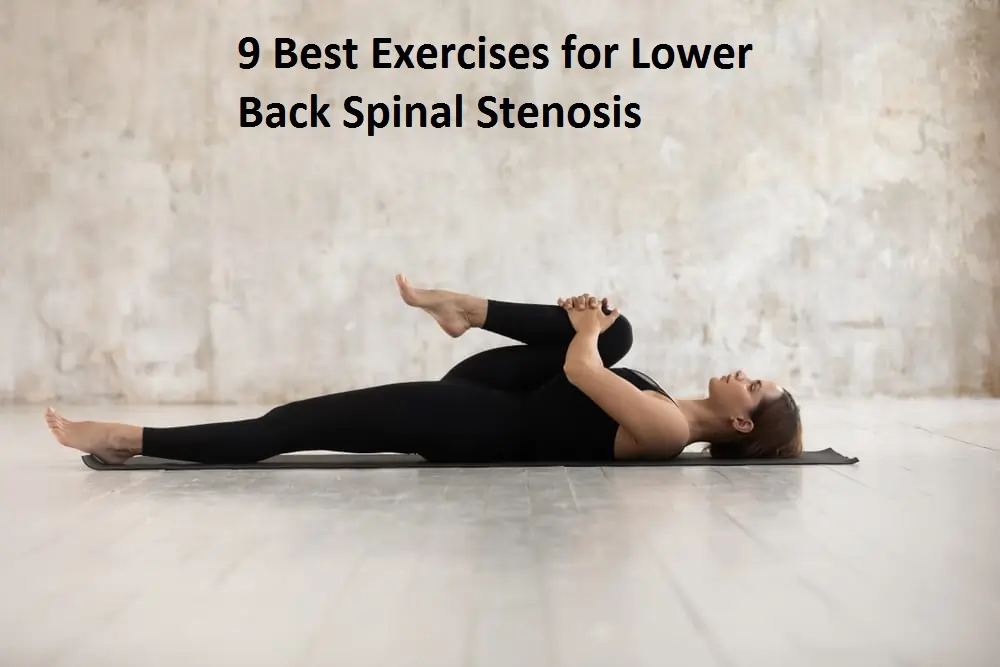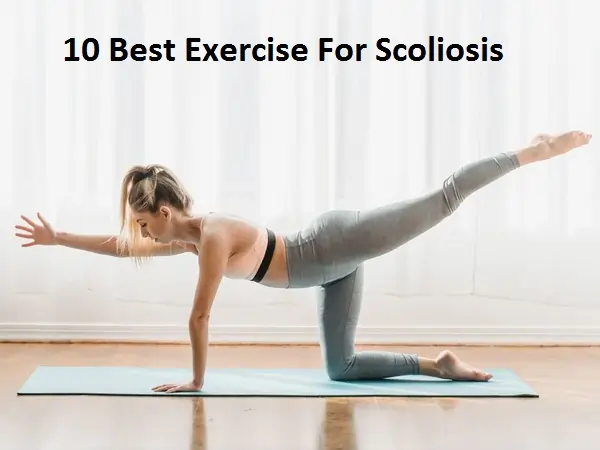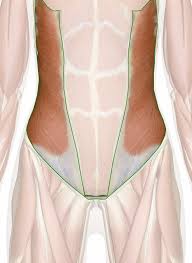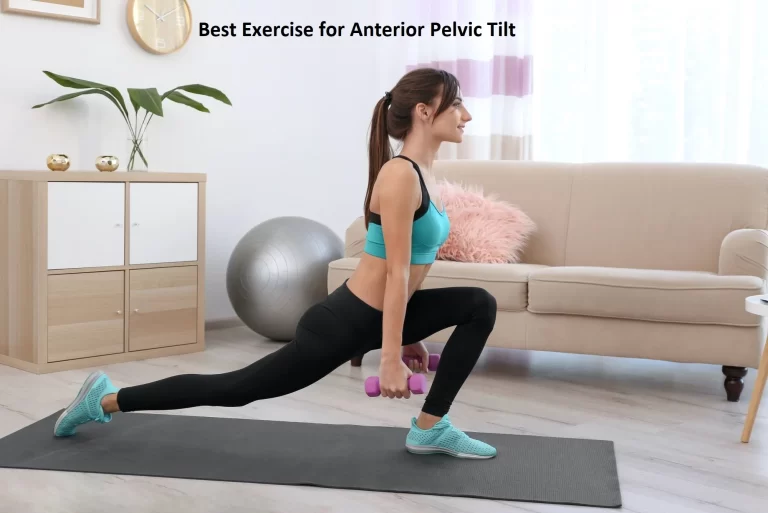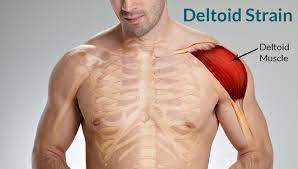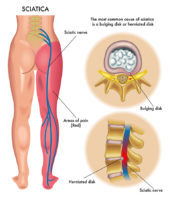9 Best Exercises for Lower Back Spinal Stenosis
Table of Contents
Overview
Lower back spinal stenosis exercises are essential for managing symptoms and for improving general function.
The purpose of lower back spinal stenosis exercises is to increase spinal stability, strengthen supporting muscles, and increase flexibility. Walking, swimming, and cycling are examples of low-impact aerobic exercises that can improve cardiovascular fitness without stressing the back.
Stretching exercises for the thighs, hips, and lower back can reduce muscular tension and improve flexibility. Mild back and stomach exercises are examples of core-strengthening exercises that can help stabilize the spine and enhance posture.
You must consult your physician or physical therapist to develop an exercise program specific to your particular condition and abilities. They can provide appropriate direction and ensure that the exercises are performed correctly and safely.
Physical treatment and exercise will increase blood flow to the stenosis area, eliminating toxic metabolites and supplying oxygen and nutrients that are needed. Exercise relieves strain on the back’s bones, nerve roots, and other immobile structures by keeping the muscles around the spine strong.
Lower back spinal stenosis is a medical disorder that arises when the spinal canal narrows, squeezing the spinal cord and nerves in the lower back. This can cause numbness, weakness, and pain in the legs, buttocks, and lower back, among other symptoms.
What is Lower Back Spinal Stenosis?
Lower back spinal stenosis occurs when the space inside the lower backbone is too small. This may result in compression of the spinal cord and nerves that go through the spine. Spinal compression usually occurs in the lower back. Lower back spinal stenosis does not always cause symptoms. Others may feel numbness, discomfort, tingling, and weakening in their muscles. Symptoms can get worse over time.
Variations in the wear and tear of the spine brought on by arthritis are the main cause of stenosis. Surgery may be necessary for patients with severe spinal stenosis. Surgery can be used to generate more room inside the backbone. This may improve the symptoms brought on by strain on the spinal cord or nerves.
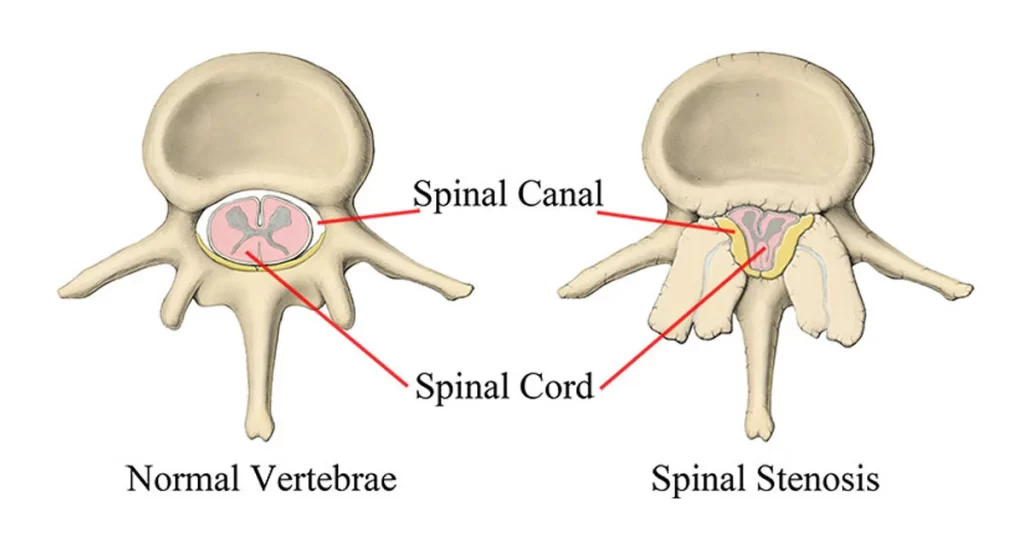
Causes:
- Tumors
- Arthritis
- Trunk injuries
- Bone spurs
- Herniated disks
Signs and symptoms:
While each person experiences symptoms differently, the following is the usual appearance:
- Standing for extended periods increases pain.
- One or both of the lower limbs hurt.
- Pain in the back
- The sensory or muscular power of the legs is altered when bending forward.
- Leg weakness, cramps, tingling, or numbness
- Reduced feeling in the feet
- Sitting, leaning forward, or walking uphill reduces pain.
The Benefits of Physical Activity:
- Through the removal of harmful metabolites and the delivery of essential nutrients and oxygen, exercise will increase blood flow to the wounded area.
- Exercise helps relieve pressure on the back’s bones and other static structures by strengthening the muscles near the body.
- Exercise can help prevent tight muscles that can exacerbate the symptoms of spinal stenosis by twisting and straining the spine.
- Training can help you maintain a healthy weight. Weight gain may result in back and leg issues.
- Maintaining an active lifestyle also improves mental and emotional health. By raising oneself and exerting force, endorphins and blood are released, which improves mood and decreases pain and health issues.
Before starting an exercise regimen, do the following:
- Before beginning any exercise program, there are a few things to consider to maximize benefits and reduce hazards. For advice on the best exercises for your specific problem, speak with a doctor or physical therapist.
- It’s necessary to take care of your health and stop from overcoming problems. Even though some stiffness is normal after working out, persistent or intense pain could be a sign that you’re pushing yourself too hard. As quickly as possible, you should progress from low-impact workouts to stronger ones.
- To avoid more injuries, it’s important to maintain proper form and technique. If you are confused about how to effectively carry out your exercise regimen, consult a physical therapist. Before starting any activity, warm up your muscles and joints to assist them prepare for the session.
9 Best Exercises for Lower Spinal Stenosis:
Child’s Pose
The calm yoga pose known as “Child’s Pose,” or “Balasana” in Sanskrit, helps to relax, stretch the back, and relax the mind. In yoga, it’s commonly used as a resting pose.
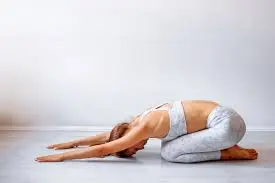
How to do
- Your big toes should be touching as you sit back on your heels.
- For a more rounded spine stretch, keep your knees together; if you want to deepen the hip stretch, separate them.
- Palms down, extend your arms straight out in front of you; rather, place them in front of your body, palms up.
- Allow your chest to drop toward the floor as you bring your forehead to the mat.
- concentrate on maintaining calm, steady breaths while holding for 30 seconds to several minutes.
Benefits of Child’s Pose
- Stretches the hips, thighs, ankles, and spine gently
- Reduces tension in the neck and lower back, encourages relaxation, lowers stress
- compresses the abdomen gently to aid in digestion.
Knee to chest stretch
The simple but effective knee-to-chest stretch helps to open the hips, relieve lower back stress, and improve flexibility.
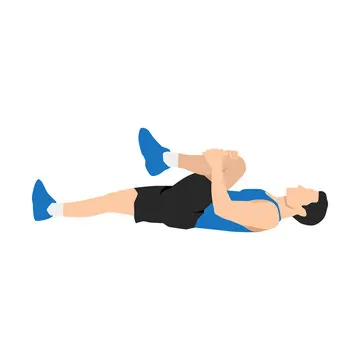
How to do
- Lay flat on your back on a comfortable surface, such as a yoga mat.
- Lift one knee to your chest while keeping the other leg extended on the ground.
- Gently push your knee with both hands. Press your knee into your chest with both hands. your chest. Hold for 20 to 30 seconds while keeping your back flat against the floor.
- Release the leg and repeat with the opposite knee.
- You can pull both knees to your chest for a deeper stretch while gently swinging from side to side.
Cat-Cow Stretch
- The Cat-Cow Stretch, also known as the Cat-Camel Stretch, is a mild spine mobility exercise that helps to build flexibility, relieve tension, and encourage good posture. It is frequently used in warm-ups, yoga, and physical rehabilitation.
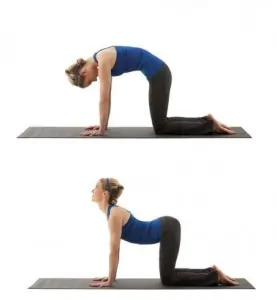
How to do
- Begin on your hands and knees in a table pose with your spine neutral. Breathing and moving
- For this purpose in cow posture, raise your sit bones, drop your stomach, and press your chest forward.
- Lift your head, drop your shoulders away from your ears, and look straight ahead.
- To get into the cat position, exhale, round your spine outward, tuck your tailbone in, and pull your pubic bone forward.
- Allow your head to fall to the floor while pressing your chin to your chest.
- Then Relax.
Seated Forward Bending
The yoga pose known as Paschimottanasana, or “seated forward bending,” is a deep stretch for the lower back and hamstrings. It is a relaxing pose that encourages digestion, eases stress, and increases flexibility.
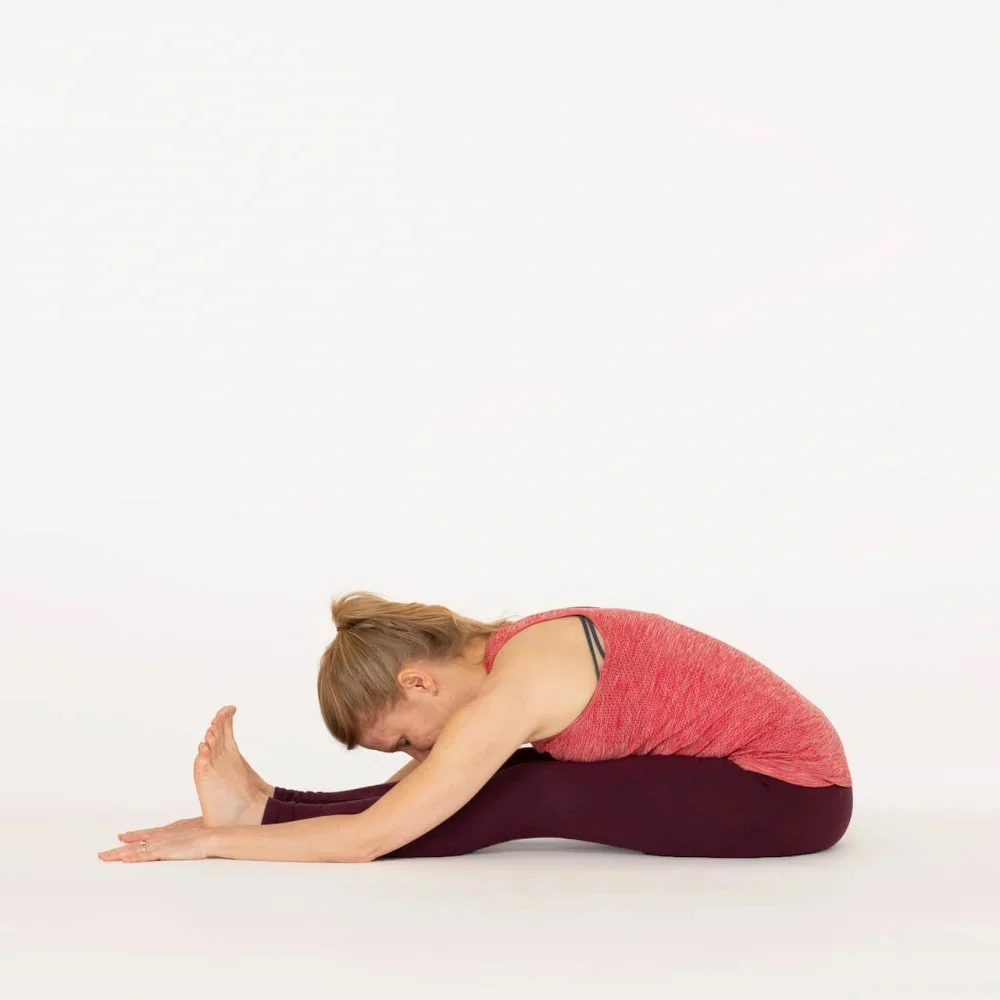
How to do
- With your legs straight out in front of you, take a seat on the floor. Keep your feet flexed and your spine straight.
- Inhale deeply while extending your arms aloft and elongating your back.
- Depending on your level of flexibility, hinge at your hips and slowly bend forward, reaching for your shins, ankles, or toes.
- First, maintain a straight back, then slowly ease into the stretch. Hold while taking deep breaths for 20 to 60 seconds.
- Take a breath and return to a seated position gradually.
Benefits of Seated Forward Bend
- Expands the calves, spine, and hamstrings.
- Enhances digestion, reduces stress, and activates internal organs.
- Improves range of motion and decreases back pain
- Reduces mild depression and menstrual discomfort
Bird Dog Exercise
The Bird Dog is a great exercise for strengthening your core, balance, and lower back. It is a good exercise to improve posture and reduce the risk of injury because it works the shoulders, glutes, lower back, and abs.
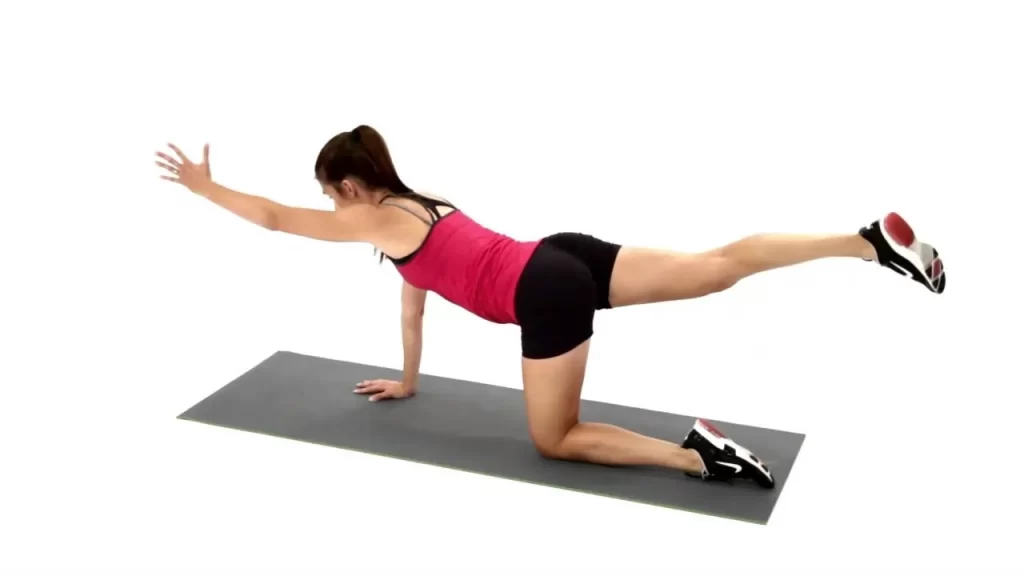
How to do
- After getting down on your hands and knees, assume the tabletop posture.
- Put your palms under your shoulders and bow at the knees.
- Check that your abs are contracting intending to keep your spine stable.
- Put pressure on your shoulder blades.
- Maintaining your hips and shoulders parallel to the floor, raise your left leg and right arm.
- Lower your chin to your chest and reach the back of your neck to look at the floor.
- Return to the starting point after holding this posture for a short while.
- Extend your left arm and lift your right leg, then hold this position for a little time.
- Then relax.
- This exercise must be performed three to six times.
Bridge Pose
Increases lower back, hamstring, and glute strength, which helps stabilize the knee.
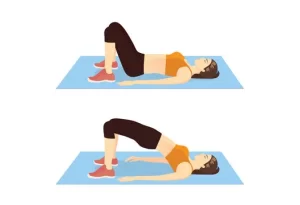
How to do
- Bend your knees while lying flat on your back with your feet hip-width apart on the mat.
- Put your hands downward and keep the arms at your sides.
- Maintaining your feet parallel to your hips, press them onto the mat.
- Confirm that your knees are pointed forward rather than sideways.
- As you inhale, push your hips toward the ceiling and your feet into the ground.
- Strengthen your thighs, hamstrings, and core as you raise your hips.
- As you raise your hips, you can link your fingers below your back or maintain your arms by your sides.
- If your arms are on the floor, continue to keep moving by pressing against the mat for support.
- Try to bring your chest closer to your chin as your hips rise without straining your neck too much.
- Keep your shoulders and neck loose.
- Keep your legs, arms, and feet firmly planted.
- Hold for five to ten seconds, raising your chest with each breath and firmly pressing your feet into the mat.
- Gently lower your hips back to the mat to release.
- Then return to your neutral position.
- Then relax.
- Repeat the same position five to 10 times.
Partial Sit Up
The half sit-up, sometimes referred to as a crunch, is an abdominal exercise that works the rectus abdominis and obliques while putting less strain on the lower back than full sit-ups.
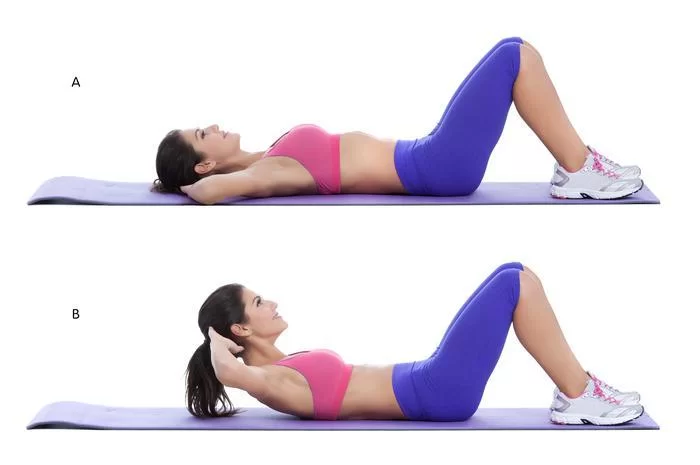
How to do
- Lie on your back with your feet flat on the floor, hip-width apart, and your knees bent.
- Cross your hands across your chest or place them behind your head without putting any pressure on your neck.
- By using your core, raise your upper back off the ground and raise your shoulder blades a few inches.
- Maintain contact with the floor with your lower back.
- As you crunch up and concentrate on contracting your abs, release your breath.
- Repeat your upper body slowly while maintaining control of the motion.
- As you return to the starting position, take a breath.
Benefits of Partial Sit-ups
- Lower back strain is reduced compared to complete sit-ups.
- Enhances posture and strengthens the core.
- Flexible to various kinds of fitness
Straight Leg Raise Exercise
The Straight Leg Raise (SLR), a straightforward but efficient exercise, can help strengthen the quadriceps, hip flexors, and core muscles. It is often recommended for individuals recovering from knee issues, undergoing post-surgery rehabilitation, or looking to build lower-body strength.
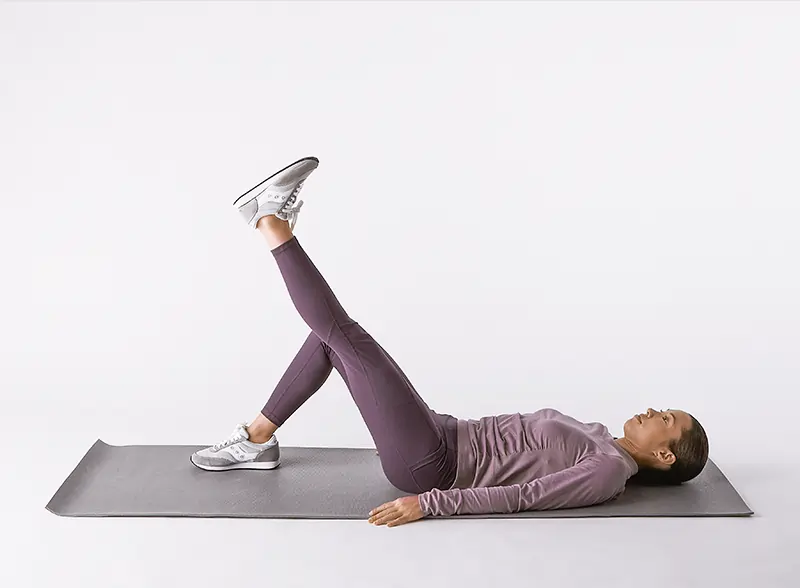
How to do
- Laying on your back, keep your foot level and position one leg flat on the floor with the other bent at the knee.
- Be careful your straight leg stays straight as you elevate it towards the ceiling.
- Allow your leg to return to the floor after a brief period of holding.
Benefits
- Strengthening the hip flexors will improve hip mobility and stability.
- You can better manage your back pain and prevent future symptoms by developing stability and core strength.
- Improve hip range of motion and flexibility.
- To avoid knee and hip issues, strengthen weaker muscles and increase stability around the hip joint.
Side stretch exercise
The side stretch exercise is an excellent way to improve flexibility, relieve side-of-body stress, and increase core mobility.
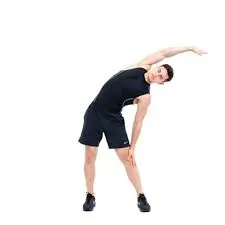
How to do
- Stand up straight and place both of your feet approximately hip-width apart.
- Raise your right arm above your head and straighten it.
- Place your left hand on your hip or stretch it along the side of your leg.
- Bend slowly to the left and feel the stretch down your right side.
- Hold for 15 to 30 seconds while keeping your core active.
- Return to the center and switch sides.
- Repeat on each side two or three times.
The benefits of Side Stretching
- Enhance the spine’s mobility.
- Reduces the stiffness of the torso.
- Enhances posture and core strength.
- Reduces stiffness in the lower back and sides.
Which safety precautions must be taken when exercising?
- To get the most out of any fitness program, there are a few things you can do before you begin. To determine which exercises are appropriate for your specific problem, speak with your physician or physical therapist.
- You must take into consideration your body and refrain from injuring yourself when you’re in pain. Although soreness is a common side effect of exercise, severe or ongoing discomfort can be caused by exercising too much effort.
- Recurrent injuries can be avoided by maintaining appropriate technique and stance. See a doctor if you have concerns about how to stick to a fitness program. Warming up prior will better prepare your joints and muscles for exercise.
- Warm-up and stretch before working out.
- While the action, keep your posture straight.
- When exercising, maintaining proper posture is essential.
- To give your body enough time to recover in between workouts.
- Avoid excessive physical exercise.
- If you experience any sudden pain, stop exercising.
- Achieve the Proper Balance
- Drink plenty of water.
When do you not exercise?
- A burning feeling in the muscles
- You’re not feeling well.
- If there is any discomfort or numbness.
- Fever
- If exercising causes you discomfort, stop.
The Top 9 Lower Back Spinal Stenosis Exercises to Reduce Pain and Increase Mobility
What types of exercises are best avoided if you have Lower Back Stenosis?
- High impact, repetitive motions,
- Heavy lifting,
- Deep spinal extension or flexion,
- Contact sports,
- Long periods of standing or walking
- Including the majority of contact sports, such as basketball or football, as well as exercises like running, jumping, aggressive cycling, deadlifts, back extensions, and toe touches.
Lifestyle modifications
With these typical modifications, your life could be changed;
- As you move forward, keep in mind not to overstress your lower back.
- Change your position often.
- Don’t spend too much time sitting down.
- Avoid positions that make you feel uncomfortable.
- Consistent practice of physical activity.
- Keep your weight under control.
- Attempt to keep your posture straight.
Which Position Makes Spinal Stenosis in the Lower Back Worse?
When you have spinal stenosis, handling your everyday responsibilities may feel like balancing on a balance beam. Certain postures may help you feel better, but others may make your situation worse. It’s critical to understand which positions to avoid to manage symptoms and stop additional damage.
Spinal stenosis causes the gaps inside your spine to narrow, which can put pressure on the nerves that travel through it. When it affects the lower back, this condition is called lower back spinal stenosis, and certain body positions can exacerbate the pain and suffering.
Extending the spine or bending backward can generally be painful. Neural systems that are already severely compressed may be further strained by this posture. You should try to avoid arching your back if you have lower back spinal stenosis.
Leaning forward, on the other hand, may help reduce pain because it somewhat increases the spaces between the vertebrae where nerves exit the body. However, maintaining this posture is neither beneficial for overall spine health nor feasible.
Another position that might exacerbate the symptoms of spinal stenosis is lying flat on your back without adequate support beneath your knees. Despite the peaceful appearance of this posture, your lower back may accidentally be under extra stress due to the unsupported curve in your lumbar region.
Sleeping in an uncomfortable position is another common cause. People frequently don’t realize how their nightly sleep habits can affect them during the day. Use supportive pillows and mattresses to help maintain a neutral spine position when you’re in a supine position.
Considering these observations collectively;
- Avoid bending back too much or too long.
- Maintaining an episode of hypertension
- Stretches or yoga positions that require backward bends
- Be mindful of how you sleep; avoid lying flat on your knees or back.
- Use mattress and pillow supports to ensure that your spine is in the right alignment.
If you are aware of these postural traps, you can move quickly over the day without making your spinal stenosis symptoms worse. Always consider making gentle motions and pay attention to your body’s signals because it will frequently tell you what is easy for you.
Summary
Nerves are found in vertebrae, which are the bones that comprise your spinal cord. Spinal stenosis is a condition where spaces inside the spinal cord narrow, putting more strain or discomfort on these nerves. In addition to tingling or numbness down one or both legs, this illness can produce lower back pain and stiffness.
Exercise can help control lumbar spinal stenosis symptoms and prevent worsening. Make an appointment with your physical therapist to learn activities that are appropriate for your condition so that you can start your lumbar spinal stenosis at-home exercise program as soon as possible. By improving your strength and flexibility, exercise can help you maintain an active lifestyle.
FAQs
What kind of exercise is most beneficial for people who have lower back spinal stenosis?
Walking is the best workout for lower back spinal stenosis if you have spinal stenosis. You may easily change the pace of this low-impact exercise to fit your needs. Every day, go for a walk (maybe during your lunch break or immediately after you get home).
Which is better for treating spinal stenosis: heat or cold therapy?
Using hot or cold therapy is a common prescription for spinal stenosis pain management. Warm treatment aids in the healing process by relaxing muscles and increasing blood flow to the injured area. Pain can be reduced by numbing the affected area using ice therapy.
What kinds of problems are typical for someone with spinal stenosis?
You may have to lean forward to relieve pressure on your lower back if you have lumbar spinal stenosis, or you may find it difficult to walk for prolonged periods. Your lower limb may become numb or ache. You may experience difficulties controlling your bowel and pee motions if it worsens.
How can stenosis be prevented?
Exercise can help control stenosis by maintaining the flexibility of your spine by extending the muscles and ligaments that support it. Walking for fifteen minutes a day while maintaining good posture is a great way to keep your back in condition.
What is the most common cause of stenosis?
Spinal stenosis is most likely caused by wear-and-tear changes in the spine caused by arthritis. People who have severe forms of spinal stenosis may need surgery in extreme circumstances. Following surgery, more space may develop inside the spine. This could reduce the discomfort caused by pressure on the spinal cord or nerves.
Is It Possible to Prevent Your Spinal Stenosis from Getting Worse?
Even though living with spinal stenosis might be challenging, there are steps you can take to prevent its progression. It’s critical to understand which acts exacerbate the issue. Avoiding particular activities and exercises that cause stress on your spinal channels might help you better manage your symptoms and stop them from becoming more restricted.
Which activities should one avoid when lower back spinal stenosis is present?
Running
Jumping
Contact Sports
Long Walks
Back Extensions
What is the most effective physical treatment for Lower back spinal stenosis?
Stretching and Range-of-Motion Exercises
Strengthening Exercises
Use of Equipment
Postural Instruction.
What is the best sleeping position for people who have spinal stenosis?
If you have this condition, it may be preferable to sleep in the fetal position, which involves bending your knees while on your sides. As a result, the nerve root is under less stress. Sleeping in a recliner chair or an adjustable bed that keeps the head and knees up can also help ease the nerves.
What are the symptoms?
Pain in the lower back
tingling or numbness in the feet, buttocks, or legs
Leg weakness
Pain that is better when you sit or lean forward and gets worse when you walk
Difficulties with coordination and balance
How is a diagnosis of spinal stenosis performed?
Spinal stenosis is diagnosed by doctors using:
Physical assessment
Review of medical history
Imaging examinations such as CT, MRI, or X-rays
What is spinal stenosis in the lower back?
The narrowing of the spinal canal in the lumbar (lower back) region is known as lower back spinal stenosis. This condition can exert pressure on the spinal cord and nerves, resulting in lower body pain, numbness, or weakness.
References
- I’ve Easy Exercises for Spinal Stenosis. 2023b, 28 December. Five Simple Exercises for Spinal Stenosis Available at https://www.hackensackmeridianhealth.org/en/healthu/2023/12/28
- Exercises for Spinal Stenosis: What to Avoid (and What to Start) – PMIR, November 26, 2023. PMIR. Available at https://paininjuryrelief.com/avoid-start-spinal-stenosis-exercises/
- Back Pain Relief Exercises for Spinal Stenosis. (n.d.). Spinal stenosis exercises: Hingehealth. https://www.hingehealth.com/resources/articles/
- Pietro Tirgar (2023e), December 13. The Top 15 Exercises for Lumbar Spinal Stenosis – Dynamic Physiotherapy Clinic. 12 of the best exercises for lumbar spinal stenosis can be found at https://mobilephysiotherapyclinic.in.
- B. S. Pt (2023d, Nov. 11). Program for Exercise for Spinal Stenosis. Verywell Medical. This is an exercise program for spinal stenosis (2696100) from VeryWellHealth.com.
- Image 9, On December 9, 2019, Farrar, J. Five Incredible Low Back Stretches. The Physio Company offers sports injury clinics and physiotherapy services. Amazing low back stretches: https://www.thephysiocompany.com/blog/2019/12/9
- Image 11, August 18, 2023b, SpineOne. This McKenzie Method of Handling Low Back Pain. Experts in Denver Spine Pain | Spine One. The McKenzie approach is used to treat back pain: The website SpineOne.com
- Image 16, On January 22, 2019, Troopers, P., & Troopers, P. The Health Advantages of Water Exercise and Swimming Troopers in the Pool. Troopers in the pool. The health advantages of swimming and water exercise are discussed at https://pooltroopers.com/blog/

